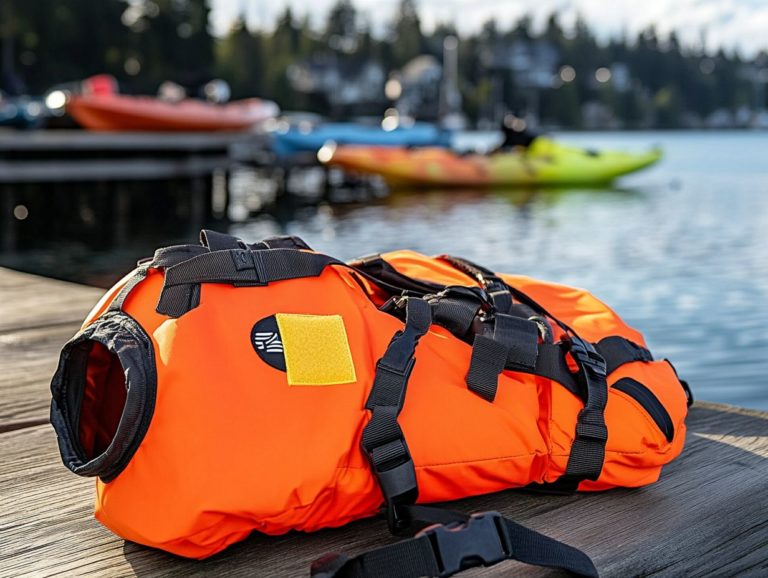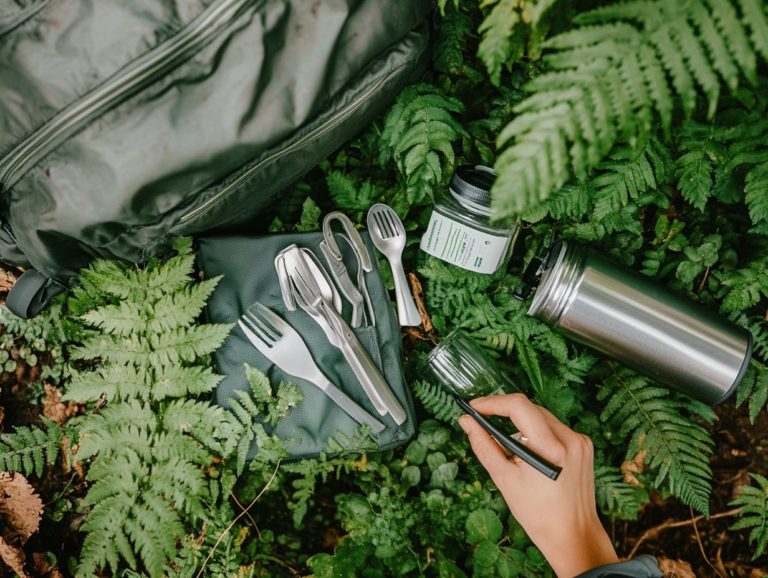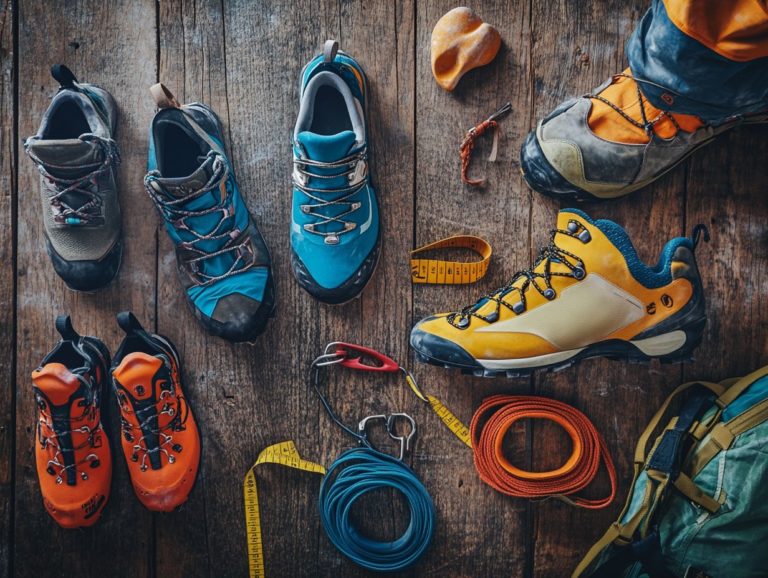Best Practices for Water Sports Equipment Care
Maintaining your water sports equipment is crucial for performance.
It also plays a key role in safety.
Whether you re a seasoned pro or a weekend warrior, grasping the advantages of regular care can significantly elevate your experience on the water.
This article delves into proper cleaning and storage techniques, along with tailored maintenance tips for kayaks, surfboards, and wetsuits, ensuring your personal well-being.
It also sheds light on common mistakes to steer clear of and offers guidance on when it s wise to seek professional assistance.
Immerse yourself in this knowledge to ensure your gear remains in peak condition!
Contents
- Key Takeaways:
- The Importance of Proper Maintenance
- Preventive Measures for Water Sports Equipment
- Specific Care for Different Types of Equipment
- Common Mistakes to Avoid
- When to Seek Professional Assistance
- Frequently Asked Questions
- What are the best practices for water sports equipment care?
- How often should I rinse my water sports equipment?
- What is the best way to store my water sports equipment?
- Why is it important to regularly inspect and maintain water sports equipment?
- Can I use any cleaning products on my water sports equipment?
- How can I extend the lifespan of my water sports equipment?
Key Takeaways:

- Regular equipment care maximizes performance and lifespan of water sports gear.
- Proper cleaning, storage, and maintenance techniques are crucial for preventing damage and prolonging the life of water sports equipment.
- Knowing how to properly care for specific types of equipment, such as kayaks, surfboards, and wetsuits, can ensure their longevity and effectiveness in water activities.
The Importance of Proper Maintenance
Maintaining your water sports equipment is crucial, not just for boosting performance but also for ensuring the safety of everyone involved in water activities.
Regular inspections and prompt repairs can greatly minimize the risks of accidents and injuries, while also considering the environmental impact of these sports.
When you neglect proper care, you open the door to equipment failure, which not only jeopardizes your well-being but could also lead to legal repercussions if safety regulations are overlooked.
Benefits of Regular Equipment Care
Regular care of your equipment in water sports brings a wealth of benefits, particularly when it comes to enhancing safety and minimizing health risks during activities like kayaking, kitesurfing, and wakeboarding.
By ensuring your gear is in top-notch condition, you significantly reduce the likelihood of accidents, which can often lead to serious injuries.
Paying attention to your equipment s upkeep translates into better performance on the water, allowing you to fully immerse yourself in the thrill of your chosen sport.
For instance, consistently checking your life jackets and harnesses can prevent malfunctions that could result in injuries or other health hazards.
Diligent equipment care can positively affect your insurance coverage. Many providers consider maintenance records when evaluating claims for accidents.
Preventive Measures for Water Sports Equipment
Take action now! Implementing smart care tips for your water sports gear is your ticket to a longer lifespan and safer adventures.
Implementing preventive measures for your water sports equipment is essential for ensuring both longevity and safety.
This is especially true in the challenging conditions you often encounter while engaging in activities like surfing and foiling.
Taking these steps not only enhances your performance but also protects your investment, allowing you to enjoy the water with confidence.
Cleaning and Storage Techniques
Effective cleaning and storage techniques are essential for your water sports equipment, allowing you to prevent damage and keep it in peak condition for all your boating and surfing adventures.
Opting for eco-friendly cleaning agents can significantly minimize your impact on marine ecosystems, helping to preserve those delicate aquatic habitats.
Regularly rinsing your gear with fresh water after each use is crucial; it eliminates salt and sand buildup that can lead to corrosion and wear over time.
By choosing biodegradable soaps, you not only maintain your equipment in excellent shape but also reduce harmful runoff into oceans and lakes.
Regarding storage, make sure to keep your gear in a cool, dry location away from direct sunlight.
This simple step can extend its lifespan and functionality, benefiting the marine life in the environment.
Don’t overlook the importance of adequate ventilation to prevent mold and mildew, which can compromise the integrity of critical items like wetsuits and sails.
Ready to enjoy your water adventures? Start taking proper care of your gear today!
Specific Care for Different Types of Equipment

Various types of water sports equipment, such as kayaks, canoes, surfboards, and wetsuits, demand specific care techniques tailored to their unique materials and usage conditions. This attention to detail is essential for both optimal performance and ensuring safety on the water.
Kayaks and Canoes
Proper maintenance of kayaks and canoes is essential. This involves regular inspections and cleaning techniques to ensure safety and prolong their lifespan.
Conduct thorough checks on vital components such as the hull, paddles, and flotation devices before venturing onto the water. Pay close attention for any signs of wear or damage, particularly in seams and fittings.
Cleaning techniques should include rinsing your kayak or canoe with fresh water after each outing. Focus on the interior to eliminate any potential mold or debris buildup. Choosing an appropriate storage method can also prevent damage from weather conditions, so using a cool, dry space or protective cover is wise.
Engaging in these practices enhances both the safety and performance of your watercraft, allowing you to fully enjoy your time on the water.
Surfboards and Paddleboards
Surfboards and paddleboards require regular maintenance for optimal performance and to ensure your water activities remain environmentally friendly.
Taking proper care involves routine cleaning after each use, as saltwater and sand can gradually cause wear. Make it a habit to inspect your gear for dings or cracks; these small imperfections can escalate if ignored.
When repairs are needed, opting for eco-friendly materials not only extends the life of your board but also protects marine ecosystems.
Prioritizing maintenance practices enhances your performance on the water while contributing to a cleaner environment, demonstrating your commitment to sustainable enjoyment of aquatic activities.
Wetsuits and Drysuits
Maintaining your wetsuits and drysuits requires proper cleaning techniques and storage practices. This ensures their longevity and effectiveness during cold water adventures.
These specialized garments are essential for anyone who dives, surfs, or kayaks in frigid conditions, providing essential insulation and buoyancy. Make it a habit to rinse them thoroughly with fresh water immediately after each use. This step removes harmful salt, sand, and chlorine, protecting your gear.
Air drying is key; keep them out of direct sunlight to avoid degradation. For storage, opt for hanging rather than folding your suits. This helps prevent creasing and maintains their shape.
Don t forget the right gear using gloves and booties can significantly enhance your overall experience and safety in water sports.
Common Mistakes to Avoid
Avoiding common mistakes in maintaining your water sports equipment is essential for preventing accidents and injuries. By paying attention to proper care and upkeep, you can ensure that you fully enjoy your water activities in a safe, worry-free manner.
Damaging Practices to Steer Clear Of

Certain damaging practices, such as using harsh chemicals or improper storage methods, can severely undermine both the effectiveness and safety of your water sports equipment.
Neglecting regular maintenance checks, such as inspecting for wear and tear, can lead to catastrophic failures. This is especially dangerous when you re out on the water.
Failing to store your equipment in a dry, temperature-controlled environment raises the risk of mold and corrosion. These can compromise how well the equipment holds up under use.
Use your gear only in the conditions it’s designed for. This helps avoid unexpected injuries or damage. By adhering to proper maintenance guidelines, you not only ensure the longevity of your gear but also significantly reduce safety risks.
Make it a habit to inspect your gear before every adventure. It keeps you safe and lets you enjoy your time on the water!
When to Seek Professional Assistance
Recognizing the right moment to seek professional assistance for your water sports equipment is essential for both safety and optimal performance. This is especially true when you start noticing signs of damage or wear.
Signs of Damage and When to Repair or Replace
Recognizing the signs of damage in your water sports equipment is essential for deciding when to repair or replace items. This ensures safety and efficiency during your activities.
Paying close attention to performance issues, such as decreased buoyancy or difficulties in maneuvering, can provide crucial insights into your gear s condition. Buoyancy is how well something floats on water.
Visual indicators like cracks, tears, or discoloration shouldn t be overlooked. They often signal wear and tear that may compromise safety.
For example, if your kayak is leaking or your life jacket shows fraying straps, these issues can pose serious risks while you’re out on the water. Taking timely action to address these problems optimizes performance and protects you from potential accidents.
It’s vital to routinely inspect your gear before diving into water sports. For tips on maintaining your equipment, check out how to care for your water sports equipment. This ensures you can enjoy your time in the water with peace of mind.
Frequently Asked Questions
What are the best practices for water sports equipment care?
The best practices for water sports equipment care include rinsing off equipment with fresh water after each use. Properly store equipment in a dry and ventilated area, and regularly inspect and maintain equipment for any signs of damage. Understanding water regulations is crucial for legal compliance.
How often should I rinse my water sports equipment?

Ideally, you should rinse your water sports equipment after each use, especially if it has been exposed to saltwater. This helps to remove any salt or other debris that can cause damage over time.
What is the best way to store my water sports equipment?
Store your water sports equipment in a dry, well-ventilated area to prevent mold and mildew. Keep it out of direct sunlight to avoid fading and damage. If you’re in a place like Florida, consider the weather that could affect your gear.
Why is it important to regularly inspect and maintain water sports equipment?
Regular inspection and maintenance ensure your gear is safe and lasts longer. Detecting issues early can prevent dangerous situations and helps you stay compliant with water regulations.
Can I use any cleaning products on my water sports equipment?
Use specialized cleaning products designed for water sports gear. They won’t damage your equipment and effectively remove buildup. Remember to follow water sports etiquette while using your gear.
How can I extend the lifespan of my water sports equipment?
To extend your gear’s life, rinse it after each use and store it properly. Regular maintenance is key, so inspect it often. Use equipment as intended and avoid excessive strain to keep it in top shape!






